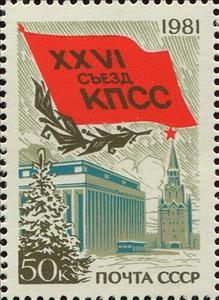Stamp: 26th Communist Party Congress (Soviet Union, USSR 1981)
26th Communist Party Congress (Soviet Union, USSR 1981)
16 February (Soviet Union, USSR ) within release 26th Communist Party Congress goes into circulation Stamp 26th Communist Party Congress face value 50 Russian kopek
| Stamp 26th Communist Party Congress in catalogues | |
|---|---|
| Michel: | Mi: SU 5037 |
| Unificato: | Un: SU 4774A |
Stamp is square format.
Stamp from souvenir sheetStamp 26th Communist Party Congress it reflects the thematic directions:
Communism (from Latin communis, 'common, universal') is a left-wing to far-left sociopolitical, philosophical, and economic ideology within the socialist movement, whose goal is the creation of a communist society, a socioeconomic order centered around common ownership of the means of production, distribution, and exchange that allocates products to everyone in the society based on need. A communist society would entail the absence of private property and social classes, and ultimately moneyand the state (or nation state).
A conference is a meeting, often lasting a few days, which is organized on a particular subject, or to bring together people who have a common interest. Conferences can be used as a form of group decision-making, although discussion, not always decisions, is the primary purpose of conferences. The term derives from the word confer.
A star is a luminous spheroid of plasma held together by self-gravity. The nearest star to Earth is the Sun. Many other stars are visible to the naked eye at night; their immense distances from Earth make them appear as fixed points of light. The most prominent stars have been categorised into constellations and asterisms, and many of the brightest stars have proper names. Astronomers have assembled star catalogues that identify the known stars and provide standardized stellar designations. The observable universe contains an estimated 1022 to 1024 stars. Only about 4,000 of these stars are visible to the naked eye—all within the Milky Way galaxy.



